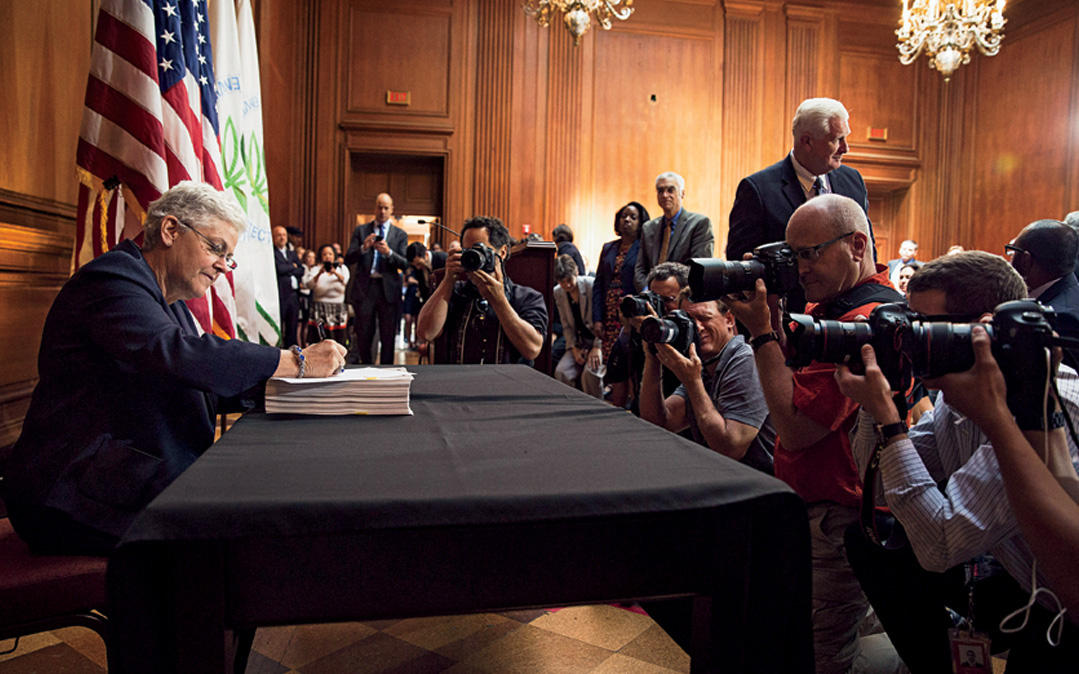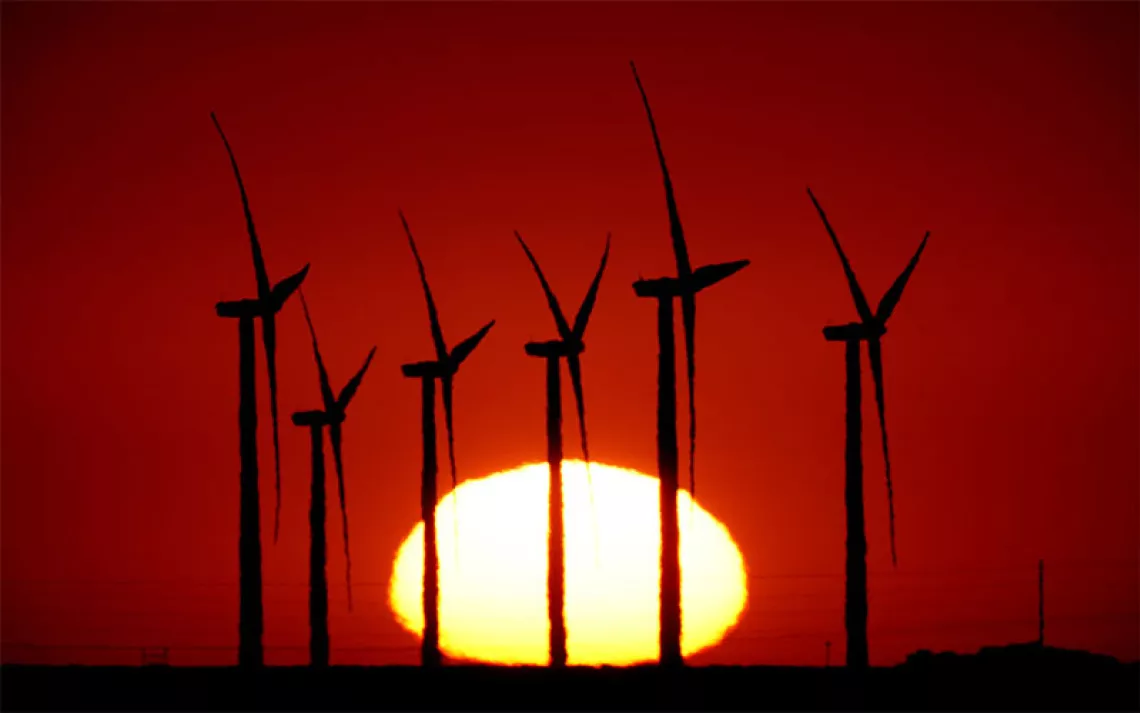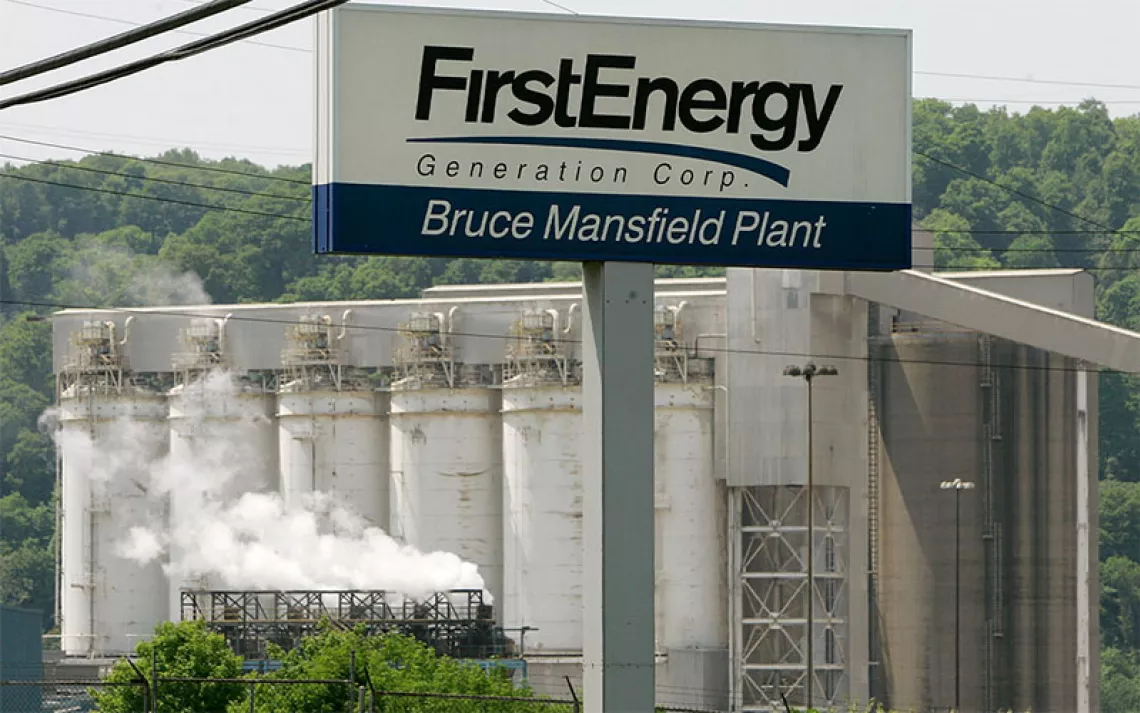A Cleaner South
In some Southern states, leasing rooftop solar panels is illegal, energy efficiency is a novel concept, and the governor lobbies for the local coal-friendly utility. How does the South get to clean power from there?

Illustration by Chris Gash
When EPA administrator Gina McCarthy announced the agency's first attempt to limit carbon dioxide emissions from existing power plants on June 2, she did what she could to avoid a civil war over energy. She spoke about coal's impact on children's health and stressed that the agency's Clean Power Plan had been created with input "from states, cities, businesses, utilities, and thousands of people." Above all, she emphasized that states have a lot of leeway in meeting the plan's goals by the 2030 target date.
"This plan is all about flexibility," McCarthy said, a sentiment she would return to frequently in coming months. "Each state's goal is tailored to its own circumstances."
McCarthy's approach failed to mute the chorus of doom from the energy industry, whose advocates argue that the plan will raise electricity rates and put people out of work. "Repeating over and over the word 'flexibility' is not an adequate defense or adequate answer to the low-income consumers in my state," Alabama attorney general Luther Strange told EPA officials at a public hearing in Atlanta, one of four regional hearings held around the country in late July. Strange has joined forces with the nation's largest private coal company, Murray Energy, and several other attorneys general to block the plan in court, and Senate Minority Leader Mitch McConnell (R-Ky.) has vowed to strip it of its funding.

EPA administrator Gina McCarthy signs the draft Clean Power Plan on June 2, giving coal-dependent states conniptions. | Joshua Roberts/Reuters Pictures
As much as Southern states like Kentucky and West Virginia depend on the coal economy, they also suffer from its health effects, and advocates for children and the elderly showed up at the hearings to enthusiastically cheer the plan. "We have an abysmal rate of asthma in Kentucky," said Joni Jenkins, a Democrat representing House District 44, which is home to two coal-fired power plants and their attendant waste dumps. Coal ash in her district, she said, "flows from the towering landfill onto my constituents' cars and homes" and "lands on their children's toys and swing sets. Fly ash lands on their vegetable gardens. And that's just the pollution we can see."
Whether the EPA's Clean Power Plan yields dramatic benefits for public health and the climate--and how much it undermines coal--depends a lot on how the states respond to the agency's offer of flexibility. Will they simply replace coal with natural gas, as some are already doing? Will they bring on more nuclear, as several Southern states are? Or will they ramp up renewable power and encourage consumers to use less electricity?
The stakes in the South are especially high, in part because the region's power plants, like Plant Scherer near Augusta, Georgia, are some of the worst polluters in the nation. This concentration of dirty energy means that states there have especially steep cuts to make. Washington State has only to close its 42-year-old Centralia coal-fired power plant to achieve its carbon-emissions reduction goal (something long in the works, thanks to the Sierra Club's Beyond Coal campaign). California, with its emerging carbon-trading market and robust support for both rooftop and utility-scale solar, merely has to stay on course to meet its modest goal of a 23 percent reduction. But Southern states like Georgia and Florida will have to close or massively retrofit coal-fired power plants and find new generation to replace them.
California has yet another advantage over the Southern states in the clean energy game: Energy efficiency has long been part of its utilities' business plans. In the 1980s, its public utilities commission "decoupled" utility profits from the number of kilowatt-hours sold; utilities now recoup their operating costs and return profits to shareholders by leveraging capital assets, embedding in consumer electricity bills a rate of return on power plants, transmission systems, and technology. That system has its own problems--it doesn't encourage individuals to produce their own power close to home, for example. But it has meant that Californians use less electricity per person than consumers in just about any other place in the country--in 2012, slightly under 600 kilowatt-hours per person each month. In Georgia, South Carolina, and Alabama--where utilities still make money on the volume of electricity sold, and thus sell as much as they can--consumers regularly use upwards of 1,000 kilowatt-hours per month. In Louisiana and Tennessee, the average monthly use per consumer often tops 1,200.
Marilyn Brown, a professor at the Georgia Institute of Technology and an expert on the South's energy markets, notes that even though per-kilowatt-hour prices in Southern states are four to six cents less than the national average, energy bills are higher "because the South uses energy so wastefully. We have 35 percent of the country's population but use 43 percent of the electricity."
It's no surprise, then, that the energy-efficiency goals of Southern Company, the utility conglomerate that owns four regional subsidiaries, are weaker than those of almost every other U.S. utility. Scraping even lower, however, is Florida Power and Light. Efficiency is measured as a percentage of a utility's overall sales. California and Massachusetts both regularly hit efficiency goals of 1.5 percent or more. Florida Power and Light recently petitioned its state's public service commission to reduce its efficiency goal to two one-thousandths of 1 percent.
The utility will likely get what it asks for, says Steve Smith, executive director of the Southern Alliance for Clean Energy, because "in the South, utilities have completely gamed the regulatory environment."
Dressed in a gray suit over a blue pinstriped shirt, Smith stood out from other clean energy activists in the Atlanta hearing room, most of whom wore T-shirts trumpeting their favored energy source. ("Keep Calm and Fission On" was popular among nuclear advocates.) Tall, with curly salt-and-pepper hair and a Southerner's flushed tan, Smith moves easily between activist circles and utility boardrooms, where he tries to make utilities understand that saving energy is in their customer's best interest. Last year, Smith's Southern Alliance for Clean Energy, the Sierra Club, and others, working with Duke Energy in the Carolinas, helped secure a deal with regulators that allows the utility to recover some costs of its energy efficiency investments. It's now been authorized to collect an extra $400,000 from its customers' bills every time annual energy savings rise above 1 percent of sales.
That determination was a coup for Smith and the Club, but it's been a hard one to repeat. Despite Attorney General Strange's purported concern for Alabama's low-income residents, for-profit utilities answer to the investors who own them, not to consumers struggling to reduce their bills. Eight years ago, Smith says, the Southern Alliance for Clean Energy had "a very detailed conversation" with Florida Power and Light about decoupling electricity pricing and introducing innovative energy-efficiency measures. The plan was to "go arm in arm" before the state utility commission to suggest changes to the utility's profit model that would make saving energy worthwhile.
Until the utility backed out. "They told us, 'Unless you can beat what we have now, we can't even consider a change,'" Smith says. Two years later, Governor Rick Scott threw out two consumer-friendly commissioners after the utility lobbied the legislature for their ouster. "That's what we're up against," Smith says. "It's that blatant."
"Power companies are powerful political forces everywhere," says Mark Woodall, chair of the Sierra Club's Georgia Chapter, "but their influence in the South goes to a higher level." He ticks off examples: North Carolina governor Pat McCrory worked for Duke Energy before he was elected; Mississippi governor Haley Barbour lobbied for Southern Company while he was in office; Rob Leebern, who chairs the board for Georgia's Department of Natural Resources, also runs Troutman Sanders Strategies, utility Georgia Power's D.C. lobbying firm. "He'll take a big part in writing Georgia's Clean Power Plan for the EPA," Woodall says. "And I guarantee it won't be all about rooftop solar."
Here's what the South's Clean Power Plans are more likely to feature: nuclear power. Nukes provide close to 60 percent of the electricity in South Carolina, a state dominated by its ties to the nation's nuclear history. Tanks along the Savannah River hold millions of gallons of high-level waste from cold war-era reactors, along with plutonium-laden detritus from weapons manufacturing. Less-potent waste from commercial reactors is stored here, too, waiting out the hundreds, thousands, or millions of years it will take for its radioactive isotopes to decay.
Not long ago, nuclear power in the South was fading, just like it was everywhere else in the country. Reactors built in the 1960s and '70s were due for expensive repairs; some were having major problems even before their current licenses expired. No new reactor had been built since the 1980s, and the few slated for construction in the 1990s had been canceled. But nuclear's fortunes began to change in the early 2000s, when advocates of the technology realized that the threat of a changing climate made nuclear power look more appealing. Because whatever else nuclear power does--squandering water, dosing rivers with radioactive tritium, leaving behind tons of radioactive waste--at least it doesn't release greenhouse gases into the atmosphere. (Its life cycle greenhouse gas emissions per watt are roughly equal to photovoltaic solar's.) Consequently, the EPA's Clean Power Plan assumes a major role for nuclear power and provides incentives to keep it going, especially in the South.
Of the eight license applications for new reactors pending before the Nuclear Regulatory Commission, none are west of the Mississippi, and seven are in the South. Five new reactors are under construction--two in South Carolina, two in Georgia, and one in Tennessee. In establishing a baseline for carbon reductions, the EPA has already factored in the carbon-free power those reactors will produce, even though the baseline year is 2012, and the reactors won't come online for years. In other words, the EPA plan not only assumes that those plants will start up as planned but also pretends that they already have.
Which means that if Southern states want to meet the EPA's steep carbon-reduction targets with nuclear power, they'll have to add even more reactors than the ones already under construction.
To Susan Corbett, who chairs the Sierra Club's South Carolina Chapter, that part of the Clean Power Plan is a disaster. On July 29, when hundreds of clean energy supporters marched down Atlanta's historic Marietta Street before the EPA hearing, Corbett and three other women carried a pale aqua banner reading "Sierra Club Nuclear Free," hoping to draw national attention to a battle she worries that environmentalists elsewhere will overlook. "They don't have this problem out west," she says. "Here in the South, we're getting screwed."
Reid Harvey, the EPA's director of air and radiation, explains that nuclear features so heavily in the Clean Power Plan "because we were worried about what would replace all these nuclear plants if they all shut down too quickly." Corbett believes the agency can do better. "If the Clean Power Plan is finalized as written, we're never going to get to a clean, green economy," she says. "We're going to end up with nuclear reactors all over the landscape and 70,000 tons of nuclear waste with nowhere to go."
"Displacing coal with nuclear," she says, "is like giving up cigarettes and taking up crack cocaine."
Steven Sondheim came to the Atlanta hearing wearing a pink baseball cap over his dust of white hair and with three University of Tennessee students in tow. Sondheim is head of the Sierra Club's Nuclear Free campaign in Tennessee, and so targets his activism at the Tennessee Valley Authority, which gets 40 percent of its generation from three nuclear plants. He has also "leaned pretty hard" on the TVA to clean up or close its aging and polluting coal plants.
In 2011, the Sierra Club, along with the National Parks Conservation Association and other activist groups, won a major lawsuit against the utility for Clean Air Act violations at 11 of those coal plants. TVA was required to invest $350 million in clean energy projects and to retire 18 of its 59 coal-fired generators before 2017.
Unfortunately, from Sondheim's perspective, TVA around the same time also chose to forge ahead on long-mothballed nuclear projects, like the two partially finished reactors at the Bellefonte Nuclear Generating Station in Hollywood, Alabama, into which it had already sunk $6 billion. In 2012, it set Bellefonte aside to focus on completing a reactor at the Watts Bar Nuclear Plant on the Chickamauga Reservoir in east Tennessee. In 2007, it was estimated that Watts Bar would cost $2.5 billion; when it goes on line in December 2015, it will have cost at least $4.2 billion for 1,200 megawatts of electric capacity, roughly enough to power two cities the size of Chattanooga.
"If someone gave you a bag with $6 billion in it," asks Sondheim, "and you wanted to reduce or avoid carbon emissions from electricity generation, what would you spend it on? I have a radical idea: Transfer the money planned for new nuclear to renewables. TVA says that they get so much electricity from nuclear that they don't need renewables or efficiency. We say, 'Why don't you look at it the other way? If you ramp up renewables and efficiency, you won't need nuclear.'"
Southern Company in Georgia is lavishing even more money on nuclear: $20 billion so far on two new nuclear reactors at its Vogtle Electric Generating Plant near Augusta. For that kind of money, Georgia Chapter chair Woodall told the EPA panel, "you could weatherize every home in Georgia."
If nuclear power is so expensive, why do big utility companies want it so badly? The answer is simple, says the Southern Alliance for Clean Energy's Smith: Like most other for-profit electricity providers in the country, Georgia Power was designed to make money not only from electricity sales but also by charging its customers for a return on its large capital projects, of which nuclear reactors are the largest and the most lucrative.
"If you're a CEO of a big utility," Smith says, "and you can move a $14 billion asset into your rate base, and you're going to get a guaranteed rate of return for the next 40 to 60 years at 10 percent or better, you're golden with your shareholders."
If there's hope for clean energy anywhere in the South, Smith says, it's probably with the quasi-governmental, "profit-neutral" TVA. The Sierra Club and the Southern Alliance for Clean Energy have both worked closely with the utility on its most recent integrated resource plan, a process utilities use to model future energy needs. "For the first time," Smith says, "we got TVA to load energy efficiency into its plan as a resource." Smith is "cautiously optimistic" that TVA's model will show that "efficiency can compete head-to-head with other forms of generation." If so, he says, "this will raise the game across the region."
Energy efficiency is just one of the easy ways Southern states can comply with the new EPA mandate. This year the Sierra Club and others managed to get a bill passed and signed in South Carolina that allows third-party leasing of rooftop solar installations. It works like this: The solar leasing company handles all installation, permitting, and utility contracts for a building owner's rooftop array, then banks the 30 percent federal tax credit. The company then charges the customer for electricity at a rate that usually beats the utility's.
More than 90 percent of New Jersey's rooftop solar installations in 2013 were done by third-party providers, and more than three-quarters of those in California, Arizona, and Colorado. The business model has carpeted schools across the West with solar arrays. But "it's unheard of in the South," says Susan Corbett. Because solar providers function as sub-utilities, providing power to customers, a half-dozen states, including Georgia, Florida, and Kentucky, forbid it, just as they forbid anyone other than the regulated utility to sell retail electricity to customers within the utility's territory. That South Carolina now allows solar leasing will likely transform the state's energy mix radically. "We have 281 sunny days a year," Corbett says.
The Sierra Club is also working toward increasing the amount of renewable electricity South Carolina and Mississippi utilities must buy back from customers with rooftop solar, a practice known as net metering. Despite its reluctance to encourage rooftop solar, Georgia Power recently did commit to building 950 megawatts of solar farms within its territory, almost enough to displace a nuclear reactor or a coal-fired generator. Corbett even dreams of offshore wind power spreading out along the shallow, accessible Atlantic coastal shelf. "The new turbines can stand up to a Category 3 hurricane," she says, "and I've never heard of a wind farm leaving behind radioactive waste."
Nothing about the Clean Power Plan is happening in a hurry, Smith points out. Its rules will be phased in over the next decade and a half--provided they survive legal challenges. Clean energy advocates, he says, should regard the rule as a backstop: "If we can't get it done sooner, [the Clean Power Plan] is coming up behind us. It's not a ceiling; it's a floor."
"We're happy with any kind of a start," Woodall says. "The Clean Power Plan is at least pushing these outlaw states to do something."
The South Can Do Better
KENTUCKY
WHAT IS: Kentucky's power plants emit the second-most CO2 per megawatt-hour in the nation.
WHAT THE EPA SAYS: The EPA predicts that the state can get partway to its 15 percent reduction goal with more efficient coal-fired power plants.
WHAT COULD BE: Photovoltaics on a fifth of Kentucky's mining-scoured mountains could power the whole state.
ARKANSAS
WHAT IS: While other states were closing coal-fired plants in the past five years, Arkansas built two new ones.
WHAT THE EPA SAYS: The state can halve electricity-related CO2 emissions by converting its coal plants to gas.
WHAT COULD BE: Arkansas has enough untapped wind energy to supply close to 60 percent of its electricity.
FLORIDA
WHAT IS: Florida utilities this year asked regulators to discontinue consumer energy-efficiency rebates.
WHAT THE EPA SAYS: The EPA bases Florida's 38 percent CO2 reduction goal on its potential for converting from coal to gas.
WHAT COULD BE: Energy efficiency in Florida could eliminate annual emissions of CO2 equal to 2.4 million cars.
SOUTH CAROLINA
WHAT IS: South Carolina splits its generation between coal and nuclear.
WHAT THE EPA SAYS: Retiring more coal-fired plants will help the state cut its CO2 emissions rate in half, as the EPA demands
WHAT COULD BE: A new state law frees up the potential for 1,600 megawatts of solar.
 The Magazine of The Sierra Club
The Magazine of The Sierra Club



